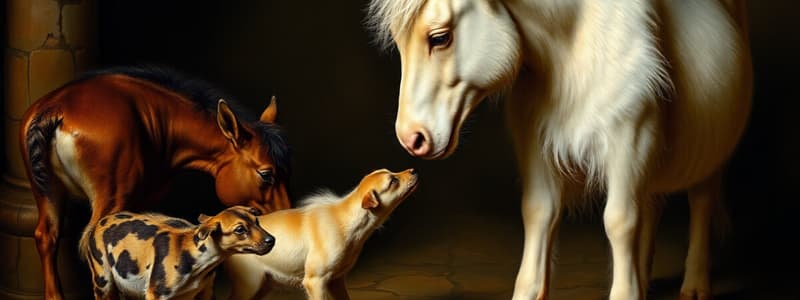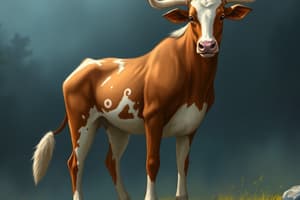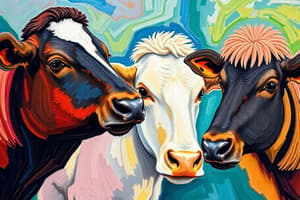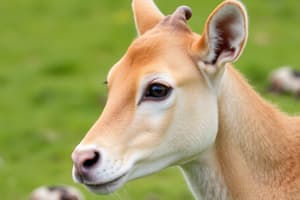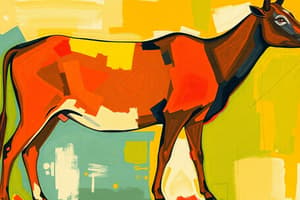Podcast
Questions and Answers
Which characteristic is commonly observed in domesticated animals due to changes in adrenal glands?
Which characteristic is commonly observed in domesticated animals due to changes in adrenal glands?
- Increased tameness
- Reduced teeth size
- Increased coat color variations (correct)
- Enhanced muscle development
Domestication primarily involves changing a population of living organisms at the physical trait level only, without affecting genetic makeup.
Domestication primarily involves changing a population of living organisms at the physical trait level only, without affecting genetic makeup.
False (B)
What was the main objective of Belyaev's fox experiment?
What was the main objective of Belyaev's fox experiment?
Simulate the process that turned wolves into present-day dogs
The neural crest hypothesis suggests that domestication is caused by a ______ in the size of the neural crest.
The neural crest hypothesis suggests that domestication is caused by a ______ in the size of the neural crest.
Match the following animal production systems with their descriptions:
Match the following animal production systems with their descriptions:
Which of the following is a key characteristic of intensive animal production systems?
Which of the following is a key characteristic of intensive animal production systems?
Colostrum is not important for newborn calves because they already have a fully developed immune system at birth.
Colostrum is not important for newborn calves because they already have a fully developed immune system at birth.
What is the main purpose of supply management in Canada’s dairy industry?
What is the main purpose of supply management in Canada’s dairy industry?
In the beef industry, ________ are the 'Foundation of the Beef Industry' and a major feed component.
In the beef industry, ________ are the 'Foundation of the Beef Industry' and a major feed component.
Which of the following factors is NOT a primary basis for Canada's Traceability Program for cattle?
Which of the following factors is NOT a primary basis for Canada's Traceability Program for cattle?
The supply management system in Canada's poultry industry ensures a steady supply of products even if it leads to oversupply.
The supply management system in Canada's poultry industry ensures a steady supply of products even if it leads to oversupply.
Why is chicken the most consumed meat in the world?
Why is chicken the most consumed meat in the world?
The Latin name for domestic swine is ________.
The Latin name for domestic swine is ________.
According to the content provided, which breed makes up the largest percentage of swine in Canada?
According to the content provided, which breed makes up the largest percentage of swine in Canada?
Domestication has significantly altered how cats look and behave compared to their wild ancestors.
Domestication has significantly altered how cats look and behave compared to their wild ancestors.
Flashcards
What is domestication?
What is domestication?
The process where a population changes genetically through selective breeding to accentuate desirable traits.
Degrees of domestication
Degrees of domestication
Wild animals exhibit fight or flight responses; domesticated animals rely on humans.
Traits Changed by Domestication
Traits Changed by Domestication
Tameness is linked to adrenal glands; coat color to melanocytes; skull formation to chondrocytes; teeth to odontocytes.
Belyaev's Fox Experiment
Belyaev's Fox Experiment
Signup and view all the flashcards
Tameness and Hormones correlation
Tameness and Hormones correlation
Signup and view all the flashcards
Neural Crest Hypothesis
Neural Crest Hypothesis
Signup and view all the flashcards
Domestication Pathways: Commensal vs. Prey
Domestication Pathways: Commensal vs. Prey
Signup and view all the flashcards
Extensive animal systems
Extensive animal systems
Signup and view all the flashcards
Intensive animal systems
Intensive animal systems
Signup and view all the flashcards
Name the key stages of the bovine lifecycle
Name the key stages of the bovine lifecycle
Signup and view all the flashcards
Supply Management in Canada
Supply Management in Canada
Signup and view all the flashcards
Importance of Colostrum
Importance of Colostrum
Signup and view all the flashcards
Importance of Forages
Importance of Forages
Signup and view all the flashcards
Canada's Traceability Program
Canada's Traceability Program
Signup and view all the flashcards
Advantages of Poultry Supply Management
Advantages of Poultry Supply Management
Signup and view all the flashcards
Study Notes
Lecture 1 Review: Domestication and Animal Traits
- Domestication is a process of genetic change in living organisms through selective breeding, enhancing traits beneficial to humans.
- Domestic animals include pets, cats, dogs, horses, and cows
Degrees of Domestication
- Wild animals exhibit "fight or flight" behavior
- Tamed animals show some dependence on humans.
- Semi-domesticated animals have a human-animal relationship
- Domesticated animals are reliant on humans.
Common Changes in Traits Due to Domestication
- Tameness is linked to adrenal glands
- Coat colour is linked to melanocytes.
- Reduced skull size is linked to chondrocytes
- Reduced teeth size is linked to odontocytes.
- Morphological changes and floppy ears can also develop.
Belyaev's Fox Experiment
- Foxes selected based on temperament with an initial population of 465.
- The objective was to simulate the process that turned wolves into present-day dogs
Fox Behaviour Percentages
- 30% were extremely reactive
- 40% were moderately reactive
- 20% were fearful
- 10% were quiet and exploratory.
- Breeding criteria focused on flight threshold distance
Tameness and Hormones
- Tameness involves a reduction in the release of stress hormones, which results in reduced fight-or-flight response and decreased reactivity to new situations
- Hormones are produced by adrenal glands
- Long-term hormones include Glucocorticoids, such as cortisol, and regulate the duration of neonatal development.
- Short-term hormones include Catecholamines, such as epinephrine and norepinephrine, which are reduced in domestic animals compared to wild animals.
Neural Crest Hypothesis
- This theory explains that genetic changes to neural crest cells cause domestication traits.
- Domestication involves a decrease in the size of the neural crest, which reduces the population of cells derived from the neural crest
- Tameness results from reduced stress hormone synthesis, because the cells that produce these hormones are from the neural crest
- A smaller number of cells involved leads to what is referred to as domestication syndrome
Wolf Domestication
- Wolves with a short flight distance took advantage of food waste from humans, giving them a competitive advantage
- These wolves tended to breed with each other and developed domestication syndrome
Domestication Pathways
- Commensal Pathway: Habituation leads to partnership, then directed breeding
- Prey Pathway: Managing prey leads to herd management, then directed breeding
Lecture 2 Review: Animal Production Systems
- Extensive systems: low capital inputs, unprocessed diets (low nutrient, high fiber), non-confined, and minimized handling and include beef cattle, sheep, and goats.
- Intensive systems: significant capital inputs, processed/nutrient-dense diets, confinement production, and economies of scale and include pork, dairy, and poultry.
Sector Types
- Cow-calf: primary, extensive production on pasture and rangeland
- Backgrounding/Stocker: managed with forage/pasture diet, slow growth.
- Feedlot/Finishing: intensive production, primarily concentrate diets
- Packing sector: intensive production, primarily feedlots with limited pasture
Animal Lifecycle Terms
- Cow: mature female
- Heifer: young female
- Bull: sexually mature uncastrated male
- Steer: castrated male before sexual maturity
- Calf: neonatal to 5 months of age
- Gestation period: 283 days, with 82 days to get pregnant post calving.
Pork Terms
- Sow: mature female pig
- Gilt: immature female pig before 2nd pregnancy
- Boar: mature male pig
- Barrow: castrated male pig
- Piglet: neonatal pig before weaning
- Farrowing: giving birth to piglets
Swine Production in Canada
- An intensive industry where pigs are typically raised in total confinement throughout their life.
- Biosecurity on commercial farms is crucial.
- Limited visitors are permitted
- Breeding is accomplished via artificial insemination
Swine Reproduction
- Gestation lasts 3 months, 3 weeks, 3 days.
- Sows are kept in individual crates during farrowing.
- Average litter size is 15 piglets, with an average birth weight of 1.2 kg.
- Colostrum intake is vital in the first 6 hours.
- Most sows have 12 teats
Swine Weaning
- Weaning is abrupt, and piglets are moved to a nursery
- They transition from milk to solid feed, are mixed with other piglets, and are weaned at 21-28 days old
Swine Grow-Finish
- After 5 weeks in the nursery, pigs are housed in large groups.
- Diets are adjusted as pigs mature.
- Pigs are ready for market in 15 weeks, weighing 125 to 130 kg.
Dairy Production
- Lifecycle: Lactation cycle to lifespan to calves
Parturition and Milk Fever
- Requires cows to mobilize large amounts of calcium from the skeleton.
- Insufficient calcium can cause muscle tremors, staggering, lying flat, heart failure, and death
- Treatment involves intravenous calcium.
Supply Management in Canada
- Quota limits are set by a national marketing agency, which determines production amounts and quotas for each province
- Minimum prices are guaranteed for producers.
- High tariffs make imported dairy products expensive
Importance of Colostrum
- New-born calves lack immunoglobulins in their bloodstream
- The small intestine of the newborn can absorb immunoglobulins into the blood for the first 24 hours after birth, providing passive immunity
- Antibodies are Y-shaped proteins that bind to bacteria/viruses for disease prevention
Lecture 3 Review: North American Beef Industry
- The North American beef industry utilizes a sectored production system involving cow-calf operations, backgrounding, feedlots, and packers
- There are currently over 90,000 producers
- The Canadian beef industry consists of 15 million cattle and calves and is primarily operated by family-run operations
Forages for Cow-Calf Nutrition and Management
- Forages, such as pasture, hay, straw, and silage, are the "Foundation of the Beef Industry"
- Forages are major feed components for beef cattle, with feed being greatest variable cost
Main Focuses of Cattle Diet
- Energy
- Protein
- Minerals
- Vitamins
- Water
Canada's Traceability Program
- Animal Identification RFID Tags, each animal must have an individual and premise ID
- Premise Identification
- Animal Movement
Dominant Cattle Breeds
- Angus
- Simmental
- Hereford
- Charolais
- Limousin
Cattle Breed Variability
- Colour
- Carcass Quality
- Behaviour
- Frame Size
- Feed Efficiency
Weaned Calf Sales
- Sell in groups through auction mart to feedlot buyers
- Via Internet/Video sales
- Forward contract with feedlot, deliver calves for a pre-arranged price (eliminating 'sale barn').
Lecture 4 Review: Poultry
- Broiler: meat chicken
- Layer: table egg production chicken
- Rooster: male chicken
- Tom: male turkey
- Hen: female turkey or chicken.
Reasons Chicken is the Most Consumed Meat
- Canada uses a supply management system, thus we produce as much as we consume
Supply Management System
- Family farms in Canada
- Not family owned in the US, hence steady income is provided to producers
- Vaccines can be limited due to political reasons
- Over 1000 broilers marks an operation as commercial
Advantages of Poultry Supply Management System
- Producers get a steady income, avoiding oversupply
- Profit allow producers to support animal welfare
- Boards have say in practices for animal welfare of birds.
Disadvantages of Poultry Supply Management System
- Product is expensive for consumers
- High quota purchase price for future producers
Lecture 5 Review: Horses
- Equus evolved in North America, migrated to Eurasia, and spread across the Eurasian steppes
- Horses were hunted for food, eventually raised in captivity, leading to domestication
- They were first used for carrying/hauling, then war tactics, evolved into riding horses
Horse Coat Colours
- Colours with selective disadvantages for wild horses exhibit negative pleiotropic effects
Horse Colour Disadvantages
- Grey horses have a predisposition for melanomas.
- Silver horses can have MCOA-related eye disorders
- Leopard Spotting is linked to CSNB
- Overo Pinto coat can cause OLWFS
- Splashed White, Overo colours are linked to deafness
- White is embryonic lethal
- Roan is also embryonic lethal
Detrimental Effects of Specialization in Horses
- Breeding for small size can lead to dwarfism
- Breeding for heavily muscled quarter horses can cause periodic paralysis.
- Selective breeding for speed can propagate fragility.
- "Popular sire" effect can cause disequilibrium between detrimental/performance genes.
Lecture 6 Review: Domestic Swine
- Domestic pigs were probably domesticated in China (490 B.C) and England (800 B.C)
- The Latin name for domestic swine is Sus scrofa domesticus
Canadian Swine Breeds
- Yorkshire (42% of herd)
- Landrace (32%)
- Duroc (25%)
- Others include Hampshire, Lacombe, Pietrain, and Berkshire
Swine Terminology
- Swine = pig
- Pork = pig meat
- Sow = mother pig
- Gilt = of breeding age, hasn't had piglets.
- Weaning = removal of young ones from their mother
- Hog = pig ready to be processed
- Process/harvest = slaughter for meat
- Boar = adult male pig kept for breeding purposes
- Farrowing = act of parturition in pigs
Pork Production in Saskatchewan
- Saskatchewan accounts for 8.5% of all pig production and known as the 5th largest producer in hogs.
Changes in Swine Operations
- Advances in technology and transportation
- Economies of scale
Lecture 7 Review: Dog and Cat Domestication & Companionship
- Cat ownership is greater than dog ownership, with 8.5 million cats as pets compared to 7.9 million dogs
- Pet cat cost averages $2,542, while pet dog cost averages $2,500 + $1,000
- Declining brick and mortar stores with an increase in online purchases
Impact of Domestication on Dogs
- Dogs originated from hunter-gatherer era stemming from unknown wolf, initial co-existence through mutual assistance and evolved into companionship
- Domestication has changed the way dogs look and behave and also increased their ability to digest carbohydrate-rich diets through the increase of amylase enzymes
Cat Traits
- Domestication has not changed the way cats look and behave
- Easily revert to feral
Pet Ownership Benefits:
- Social support
- Companionship
- Improved mental health
- Motivates exercise
- Animal assisted therapy and activities
- Teaches empathy, social skills, and self-esteem
Pet Ownership Risks:
- Infections, parasites
- Allergies
- Bites, injury
- Financial burden
- Psychological burden when pets die
- the Neglect of animals
Contrasting Animal Assisted Therapy/Activities
- Animal assisted therapy include treatment in patients who are physically/socially/emotionally/cognitively challenged and have treatment with stated goals, individual treatment, scheduled appointments, detailed notes, and are administered by a trained health professional
- Animal assisted activities include casual activities involving pets/peoples, general socialization, typically volunteer run, and can be as long/short as necessary
Lecture 8 Review: Dairy Cattle Management
- Milk production is tailored to meet Canadian demand
- Dairy exports and milk product imports are limited
- The quantity of milk required is established province to province
Dairy Cattle Management from Birth to First Dry Off
- Mostly bred through artificial insemination to produce a calf every 365 days
- Calves housed indoors and fed milk replacer, the shift to a grower phase, promoting rapid lean tissue growth
- Dairy cattle will breed at 13-15 months, will calve first at around 22-24 months
Aspects of Dairy Cattle Management
- Colostrum management and passive transfer
- Changes in milk yield of dairy cattle over time
- Importance of cow-comfort
- Characteristics of the mammary gland.
- These cows cannot reach their genetic potential without the proper housing & nutrition
- Calm handling
Mammary Gland Management
- "Take it or lose it policy" is in effect to increase cells from the early frequent milking during early lactation that stimulates cell development in the mammary gland, which has carry-over effects
- Nutrient demand increases tremendously in lactation
Lecture 9 Review: Indigenous Principles for Sustainable Aquaculture
- There are distinct Indigenous peoples of Canada with their own culture, history, practice, and beliefs: First Nation, Metis, Inuit
- Transparency and First Nations Inclusiveness
- Social responsibility
- Environmental responsibility
- Economic responsibility
Differences Between Aboriginal/Non-Aboriginal Aquaculture
- May include unique cultural and spiritual aspects
- Unique connections to the land
- Mistrust of conventional science
- Unique rights and special access to aquatic resources
- Job creation
- High food prices
Studying That Suits You
Use AI to generate personalized quizzes and flashcards to suit your learning preferences.
